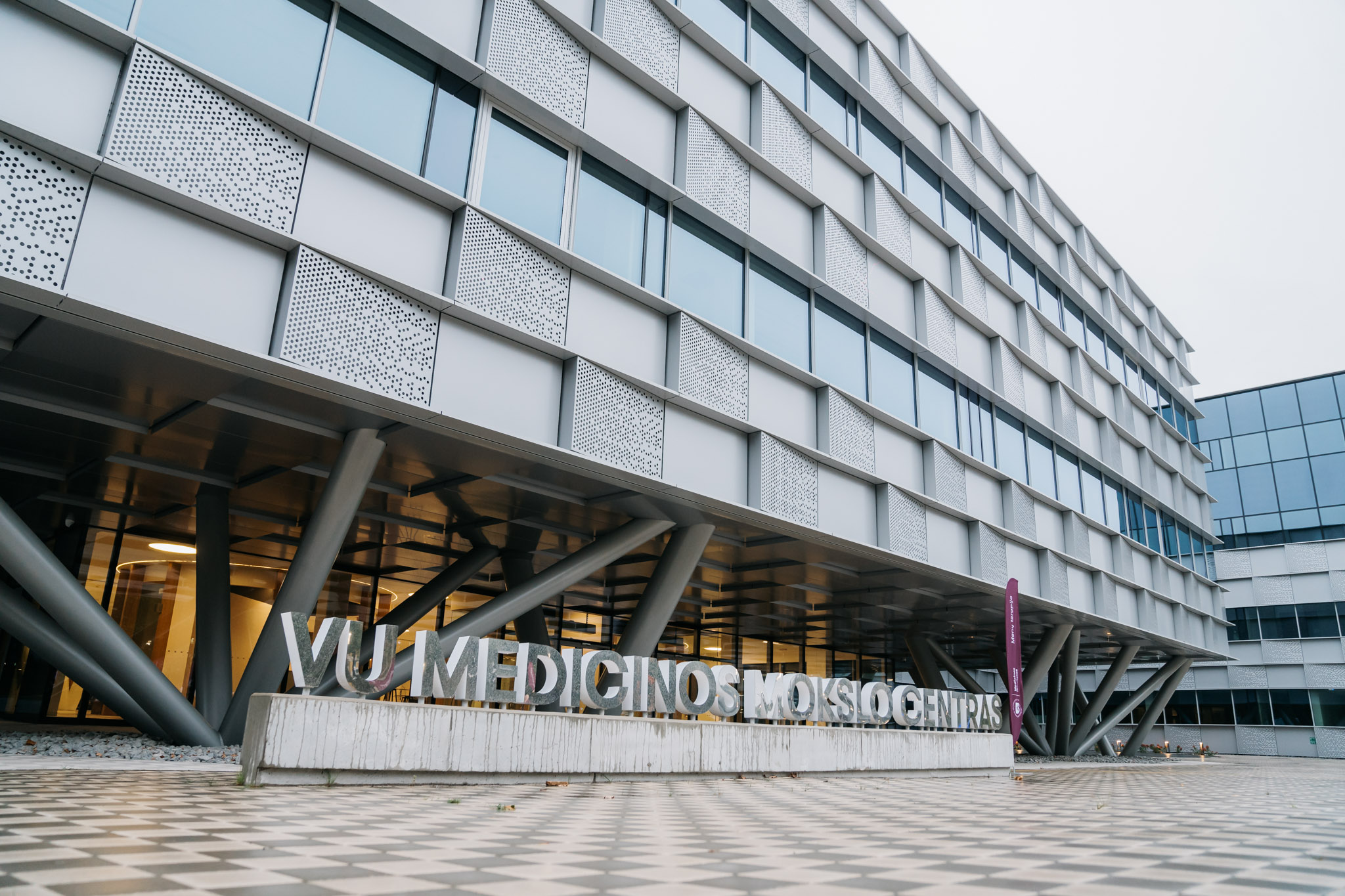 VU Faculty of Medicine Science Center / Photo – Mantas Repečka
VU Faculty of Medicine Science Center / Photo – Mantas Repečka
The Medical Science Centre of the Faculty of Medicine at Vilnius University (VU MF) opened today in Vilnius, located in the Santara Valley. This is the largest independently funded investment in medical science infrastructure in Lithuania. The main goal of the new centre is to translate fundamental scientific discoveries into practical solutions for medicine.
The faculty’s new Medical Science Centre houses unique laboratories and research centres. It will use a wide range of tools – from human cell cultivation and modern molecular research to digital technologies – to develop translational, personalised and digital medicine.
The centre will host a range of genetic, biomarker research, neuroscience, dental and other laboratories, as well as strengthen the fight against cancer with artificial intelligence tools developed and patented by the centre’s research scientists. The complex will also host the country’s only biobank (the Population and Rare Diseases Biobank), set up to collect biological samples from across the Lithuanian population. It is expected to be a major boost to the development of personalised medicine in Lithuania, to which other scientists working at the Centre will also contribute.
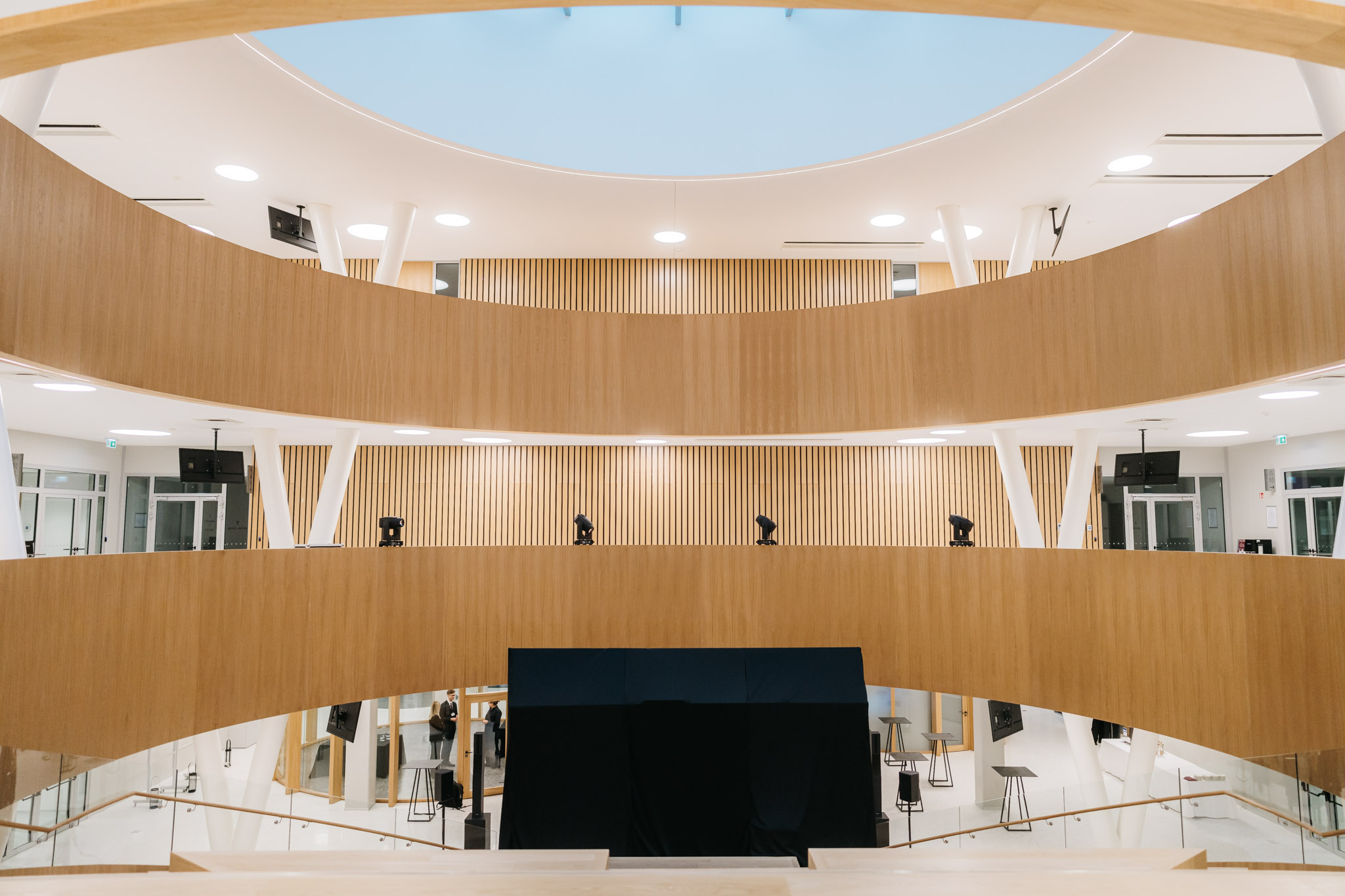 VU Faculty of Medicine Science Center / Photo – Mantas Repečka
VU Faculty of Medicine Science Center / Photo – Mantas Repečka
And that’s just a small part of the new centre’s capabilities: the entire centre comprises six buildings and nearly 900 individual rooms, all equipped with research facilities of the highest standards. The building covers a total area of 19,000 square metres and represents a total investment of €66 million, including €36.6 million from the European Regional Development Fund.
The opening ceremony took place on Thursday and was attended by the Prime Minister, the Minister for Health, Education, Science and Sport, the Vice-Minister of the Economy and Innovation, a large community of medical scientists, politicians and business representatives.
The large audience of participants attending the ceremony said that the Centre will bring scientific activities to a new qualitative level and will contribute to achieving breakthroughs in the field of medicine, that will ultimately benefit not only Lithuanian society, but also populations in other countries.
 Dean of the Faculty of Medicine, Prof. Dr. Dalius Jatužis, Prime Minister Ingrida Šimonytė, VU Rector Rimvydas Petrauskas / Photo – Mantas Repečka
Dean of the Faculty of Medicine, Prof. Dr. Dalius Jatužis, Prime Minister Ingrida Šimonytė, VU Rector Rimvydas Petrauskas / Photo – Mantas Repečka
“This innovative and much-needed Medical Science Centre is a sign of a country that is rich in talented and intelligent people, that is growing in strength and setting outstanding standards for itself. The Centre’s state-of-the-art infrastructure, modern facilities and location on the Santariškės Medical Campus will support the synergy between the best research and clinical practice. This in turn will contribute to the development of innovation, the more effective treatment of patients, especially in the fight against rare and serious diseases, and the transfer of experience to the younger generation of specialists and researchers,” said Prime Minister, Ingrida Šimonytė.
Prof. Rimvydas Petrauskas, Rector of Vilnius University, noted that the opening of this centre is a significant event in the history of the University.
“We are launching the University’s Medical Science Centre, to pursue excellence in both basic science and science-based clinical treatments. It is very important that this centre has opened on this campus, which is increasingly becoming a place not only for medical treatment, but also for scientific research and studies.
The ability to work across all the fields, the combination and integrity of science, the studies and practical applications, is essential for success. This is especially true in medicine, where scientific and therapeutic advances have achieved an incredible momentum”, explained Prof. Petrauskas.
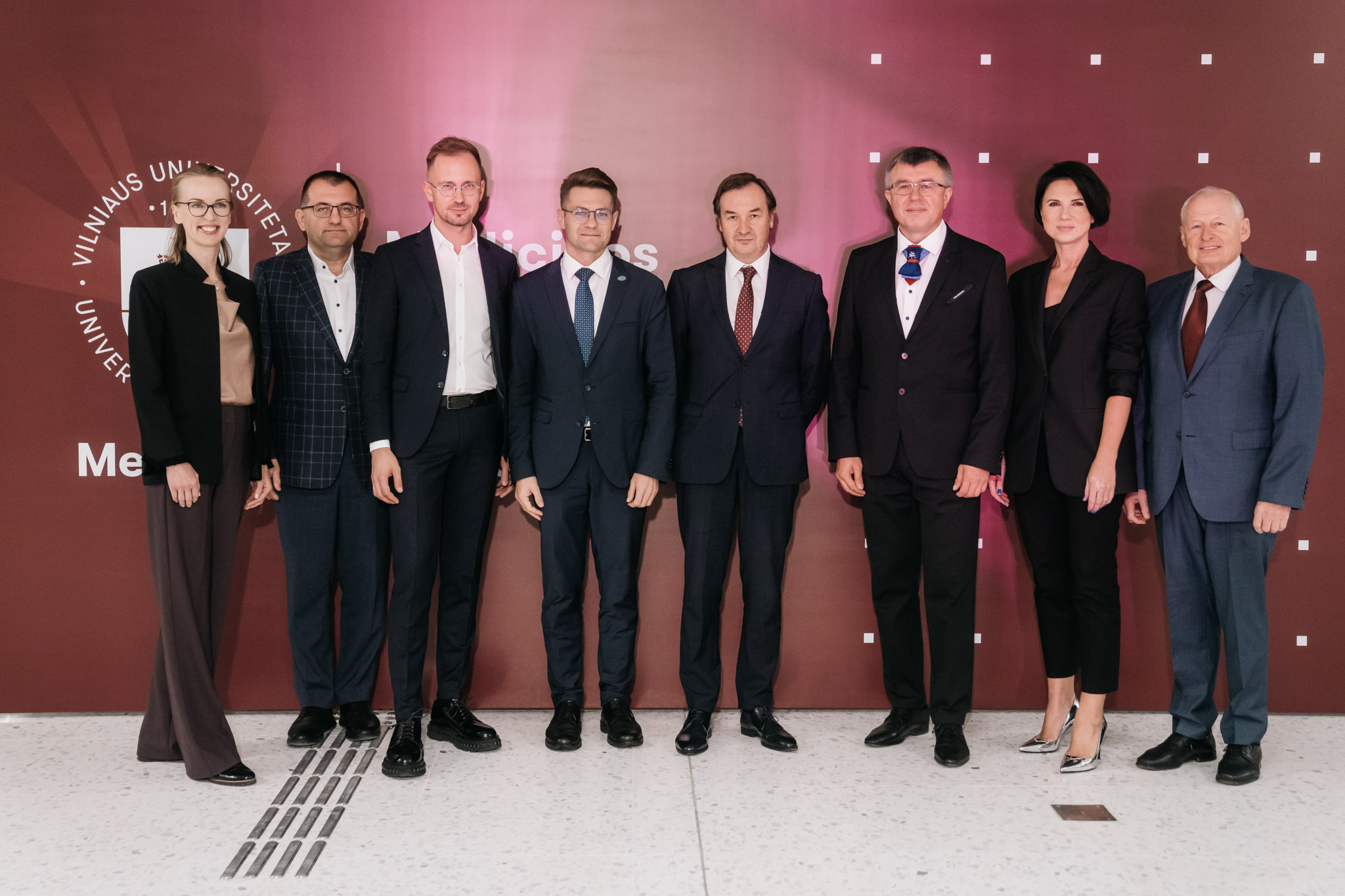 Moment from the opening of the VU Faculty of Medicine Science Center. From left: Head of the Biobank, Dr. Giedrė Kvedaravičienė, Vice-Dean for Postgraduate Studies Prof. Dr. Vytautas Kasiulevičius, Vice-Dean for Science and Innovation Assoc. Prof. Dr. Karolis Ažukaitis, Minister of Health Aurimas Pečkauskas, VU Rector Prof. Dr. Rimvydas Petrauskas, Dean of the Faculty of Medicine Prof. Dr. Dalius Jatužis, Director of the Institute of Odontology Prof. Dr. Vilma Brukienė, Vice-Dean for Infrastructure and General Affairs Dr. Aleksas Pikturna / Photo – Mantas Repečka
Moment from the opening of the VU Faculty of Medicine Science Center. From left: Head of the Biobank, Dr. Giedrė Kvedaravičienė, Vice-Dean for Postgraduate Studies Prof. Dr. Vytautas Kasiulevičius, Vice-Dean for Science and Innovation Assoc. Prof. Dr. Karolis Ažukaitis, Minister of Health Aurimas Pečkauskas, VU Rector Prof. Dr. Rimvydas Petrauskas, Dean of the Faculty of Medicine Prof. Dr. Dalius Jatužis, Director of the Institute of Odontology Prof. Dr. Vilma Brukienė, Vice-Dean for Infrastructure and General Affairs Dr. Aleksas Pikturna / Photo – Mantas Repečka
Prof. Dr. Dalius Jatužis, Dean of the Vilnius University Medical Faculty, says that the greatest strength of the new centre is that it brings together the strongest specialists and clinical-scientists from various fields of medical science under one roof.
“By locating the centre in the Santara Valley, close to all major medical institutions involved in the treatment and care of the most complex patients, and by having the country’s first biobank, we are building the ecosystem and becoming an important link in the ecosystem, which to date, has been lacking,” said Dr. Jatužis. “Equipment is not the most important thing here. The equipment in Lithuania is already quite abundant and high value. First, we need brains concentrating on a clear goal. I think this is the most important element of the Medical Science Centre: we have brought specialists working in various fields of medical science together under one roof, who will also work with clinical-scientists. I do not doubt that this will give a major boost to one of the key strategic goals of medical science – to translate scientific discoveries into solutions that can be used in medicine.”
Karolis Ažukaitis, Associate Dean for Science and Innovation at the Faculty of Medicine, explained, that by bringing together researchers and doctors, the aim will be to integrate scientific research into practical medicine:
“We will try to ‘communicate directly’ from the laboratory to the patient’s bedside and back again –aiming to apply scientific discoveries made in our laboratories directly to the treatment of patients, and then bring the results back to the laboratory for further research and development. This reflects the essence of translational research, where scientific discoveries are translated into practical treatment solutions that improve people’s health.”
 Laboratories of the VU Faculty of Medicine Science Center / Photo – Mantas Repečka
Laboratories of the VU Faculty of Medicine Science Center / Photo – Mantas Repečka
The country’s biobank will help us better understand the health of the Lithuanian population
The new centre will carry out complex research in various fields of medical science and develop new advanced tools aimed at improving the effectiveness of treatment used for the most serious diseases and the prevention of ill health.
The Centre for Applied Neuroscience will carry out sleep studies in dedicated environments, isolated from environmental noise, to record various changes in the body’s activity during sleep. It will also use state-of-the-art equipment to carry out live brain research, including assessments of cognition, motor functions, brain bioelectricity and blood flow. This will help the understanding of early changes in brain function as various diseases progress.
Research on population genetics, human genomics and gene regulation will be carried out in a number of genetic research laboratories. Biomarker studies based on a wide range of innovative and cutting-edge molecular techniques will also contribute to the more accurate diagnosis or prediction of diseases.
The new centre also houses the country’s first Biosafety Level 3 laboratory, which will allow research into highly contagious and dangerous agents. To ensure safety, the specialists working here will wear special protective clothing covering their entire body and will work in a fully isolated, pressure-controlled environment.
The establishment of the Medical Science Centre also launches the country’s first Palaeogenetics Laboratory, which provides the infrastructure for studying ancient plant, micro-organism and even human DNA from bones and other preserved tissues. For example, the laboratory will be used for research into the genetic, nutritional and health characteristics of partisans, Napoleonic soldiers and ancient nobles.
The centre is also home to Lithuania’s first Population and Rare Disease Biobank. This is a repository for biological samples from consenting participants, such as blood, saliva, skin, urine, tissue biopsies and other health and lifestyle information.
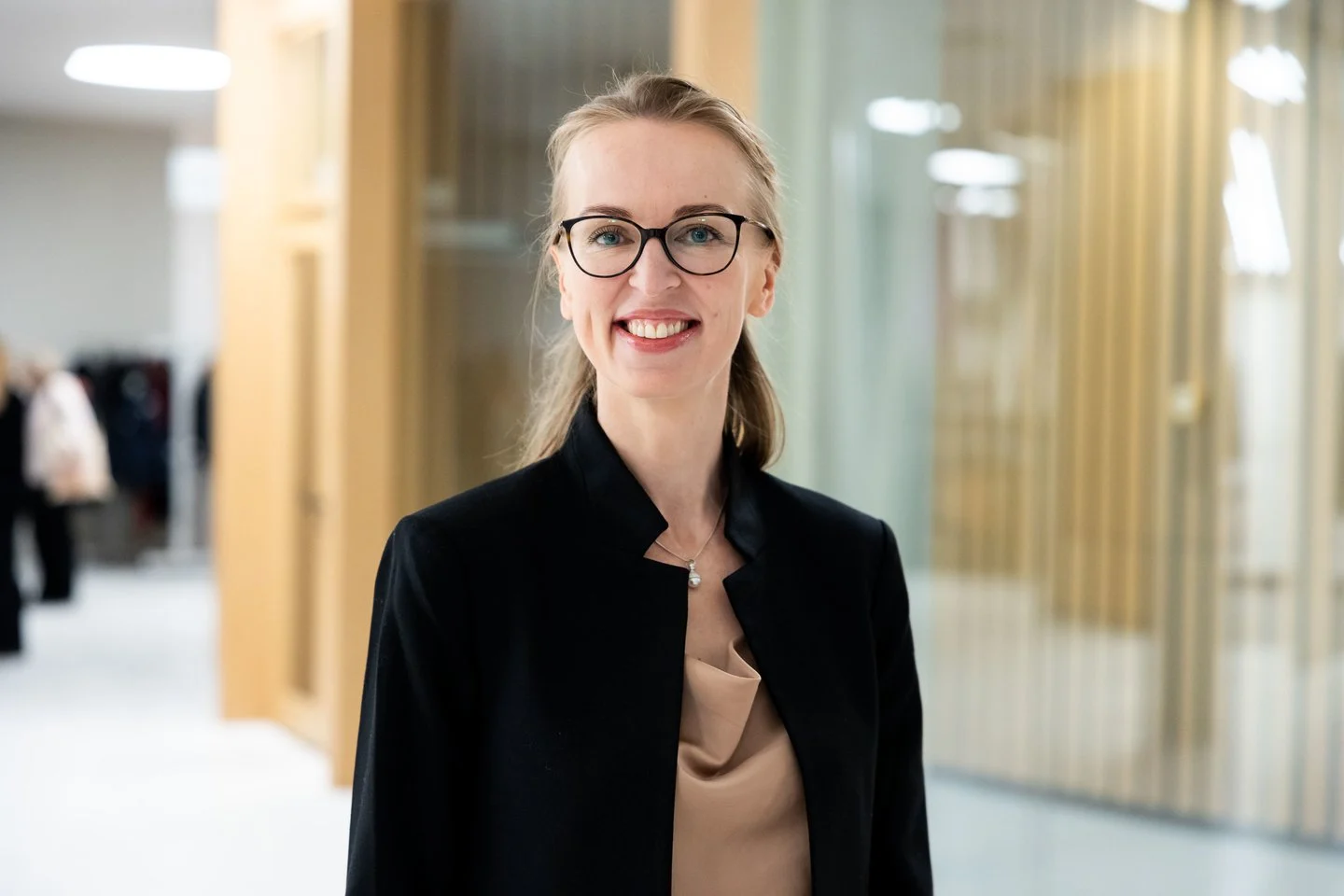 Head of the VU MF Lithuanian Population and Rare Diseases Biobank, Dr. Giedrė Kvedaravičienė / Photo – Mantas Repečka
Head of the VU MF Lithuanian Population and Rare Diseases Biobank, Dr. Giedrė Kvedaravičienė / Photo – Mantas Repečka
The country’s first population biobank, in common with other biobanks established in Lithuania, belongs to the international BBMRI-ERIC network. This new facility will help us better understand the health characteristics of the Lithuanian population today, and the impact of genetic and environmental factors, including lifestyle, on the onset and development of various diseases. Using biological samples from the current Lithuanian population, the biobank will carry out a wide range of biomedical research and systematically collect information on the health and risk factors of the healthy Lithuanian population. According to Dr Giedrė Kvedaravičienė, Director of the Lithuanian Population and Rare Diseases Biobank, combining this information with the collections of samples and data of patients with oncological, genetic and other diseases from other biobanks in Lithuania will open up new opportunities for the implementation of personalised medicine in Lithuania.
“Our biobank will fill an important niche in the field of biobanking by complementing the samples collected by other members of the Lithuanian National Biobanking Consortium using a reliable collection of healthy population samples and data. Through long-term studies, we will collect data on the genetic basis, risk factors and mechanisms of disease development from the most pressing health problems in Lithuanian society. All this will provide the missing tools for medical innovation and will help to enable personalised medicine as a standard medical practice in our country”, said Dr Kvedaravičienė.
The director also pointed out that different peoples are not genetically identical, and national characteristics can be quite significant, as illustrated by international and Lithuanian research. “Therefore, comprehensive national population data collected in a high quality and consistent manner, and national medical practice based on this data, with a personalised approach to both treatment and prevention, can have a significant impact on public health. For example, it can help us to find out why Lithuania has such a high incidence of cardiovascular disease, where our rates are among the worst in Europe. Having a population-based biobank collection with complete health information will allow us to make recommendations for assessing risk factors. This will help GPs to identify high-risk patients earlier and more accurately, and ensure more effective disease prevention and treatment.”
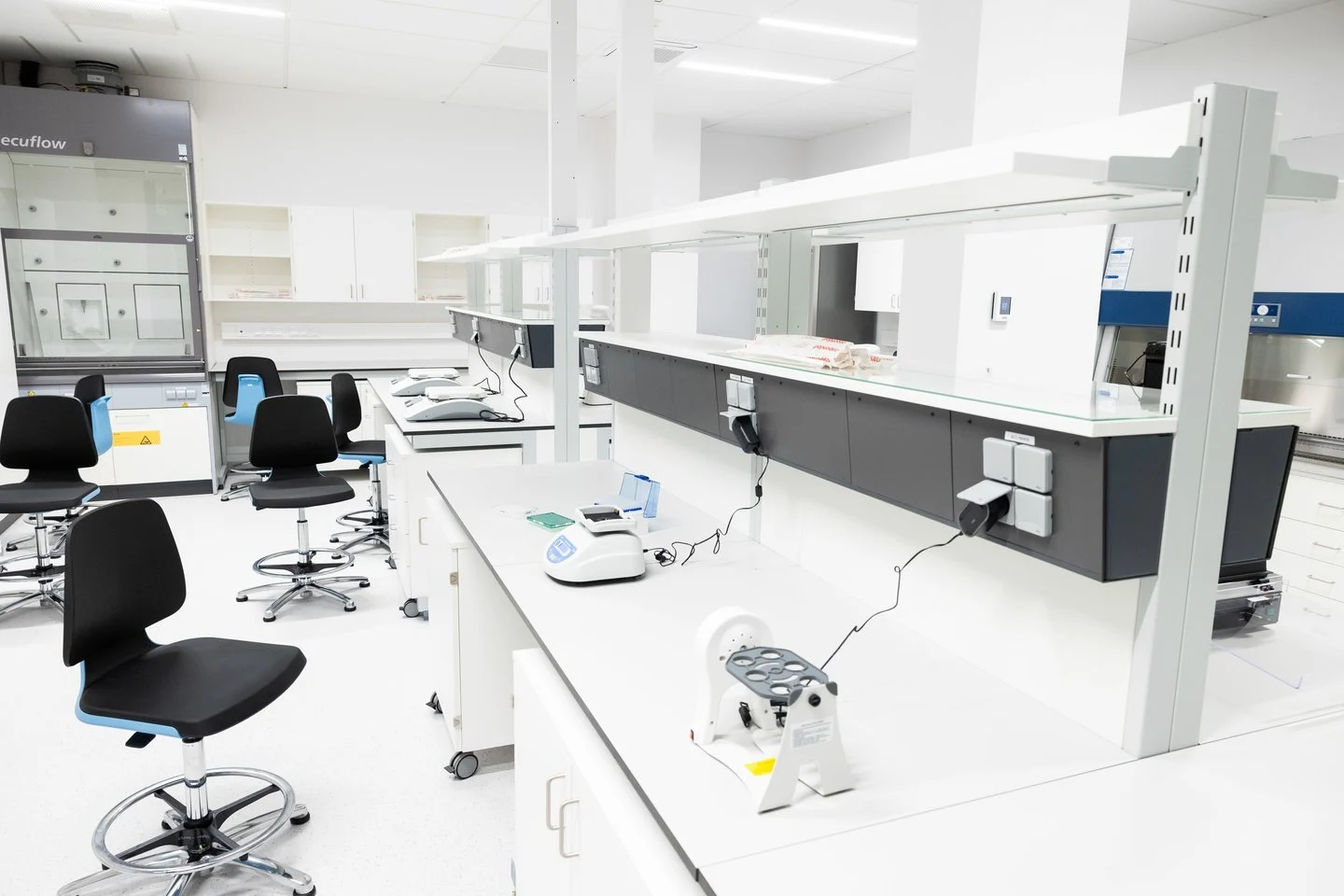 Laboratories of the VU Faculty of Medicine Science Center / Photo – Mantas Repečka
Laboratories of the VU Faculty of Medicine Science Center / Photo – Mantas Repečka
Organoids will be grown at the Medical Science Centre
Another promising innovation in medical science to be developed at the new centre is that teams of scientists will use the latest technologies to grow organoids, or small versions of human organs using pluripotent stem cells. The process of creating organoids is complex and challenging, and it is hoped that by bringing together scientists with the right expertise and collaborating with first-class international colleagues, a breakthrough in this field can be achieved.
“Yes, we have both the tools and the capabilities to grow and study organoids at the Medical Science Centre,” Dr Andrius Kaselis, a neuroscientist and Senior Specialist for the development of the Science Centre at VU MF, explained with confidence.
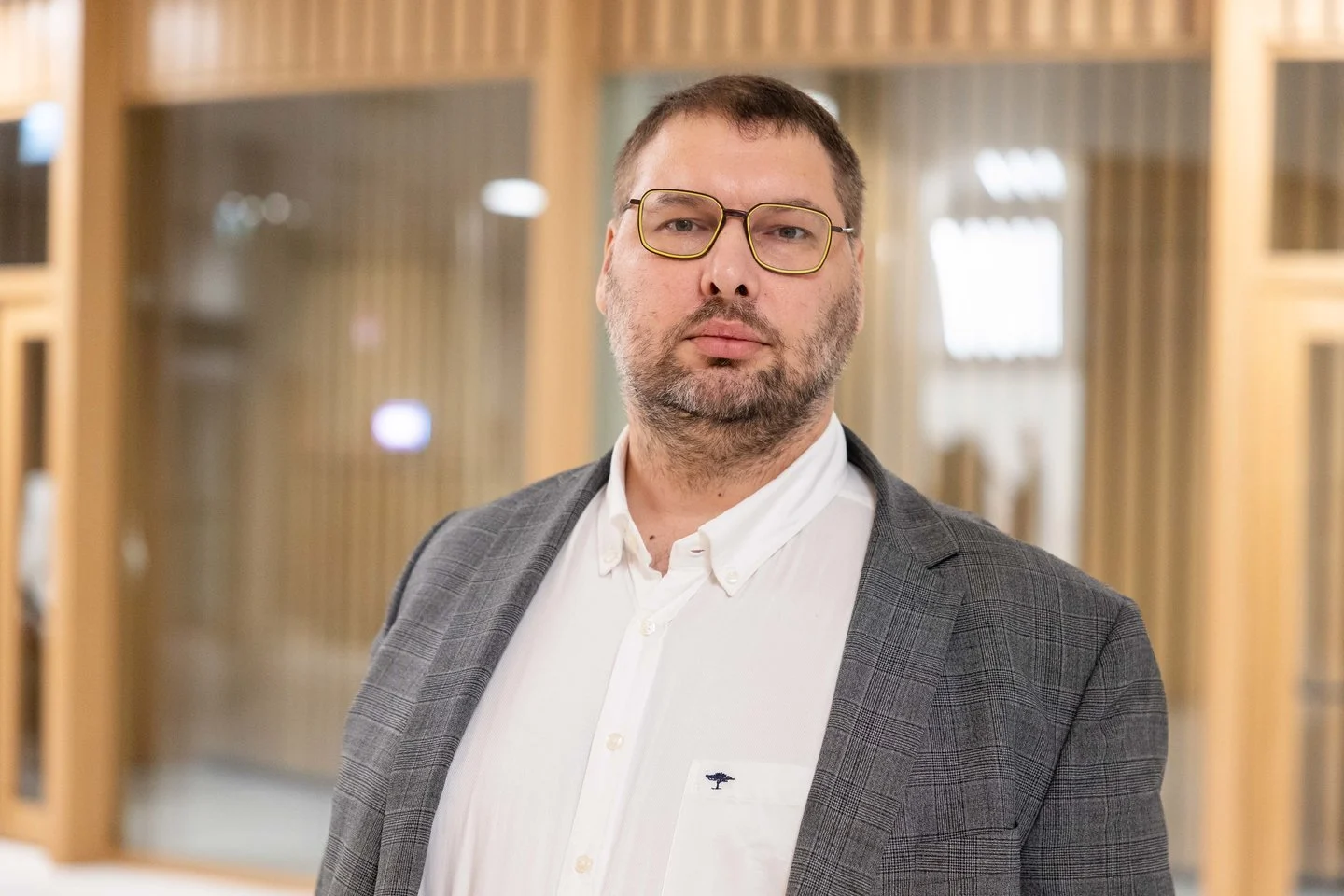 VU MF Chief Specialist for Science Center Development, Dr. Andrius Kaselis / Photo – Mantas Repečka
VU MF Chief Specialist for Science Center Development, Dr. Andrius Kaselis / Photo – Mantas Repečka
He went on to say, “An organoid must functionally and structurally mirror an existing organ. This means that the cells in that organ must be viable and able to perform one or other of their inherent functions. The development of this technology and of methods for growing organoids is currently the focus of a huge amount of effort and investment worldwide, since it is one way to reduce the use of animals for testing pharmaceuticals – by growing the right organoid, the research can be even more efficient than using animals for testing. Therefore, one of the main areas where organoids can be used is in the development of pharmaceuticals.”
Another important application for organoids is oncology.
“Suppose we take a sample of a malignant tumour from a patient and grow that tumour outside the patient’s body, studying its structure and properties in detail, then we will be able to get answers much more easily and more quickly on how that tumour should be treated the actual treatment of that particular patient. Currently, destroying a tumour without knowing exactly how it responds and how it is structured can be very difficult,” explained the neuroscientist.
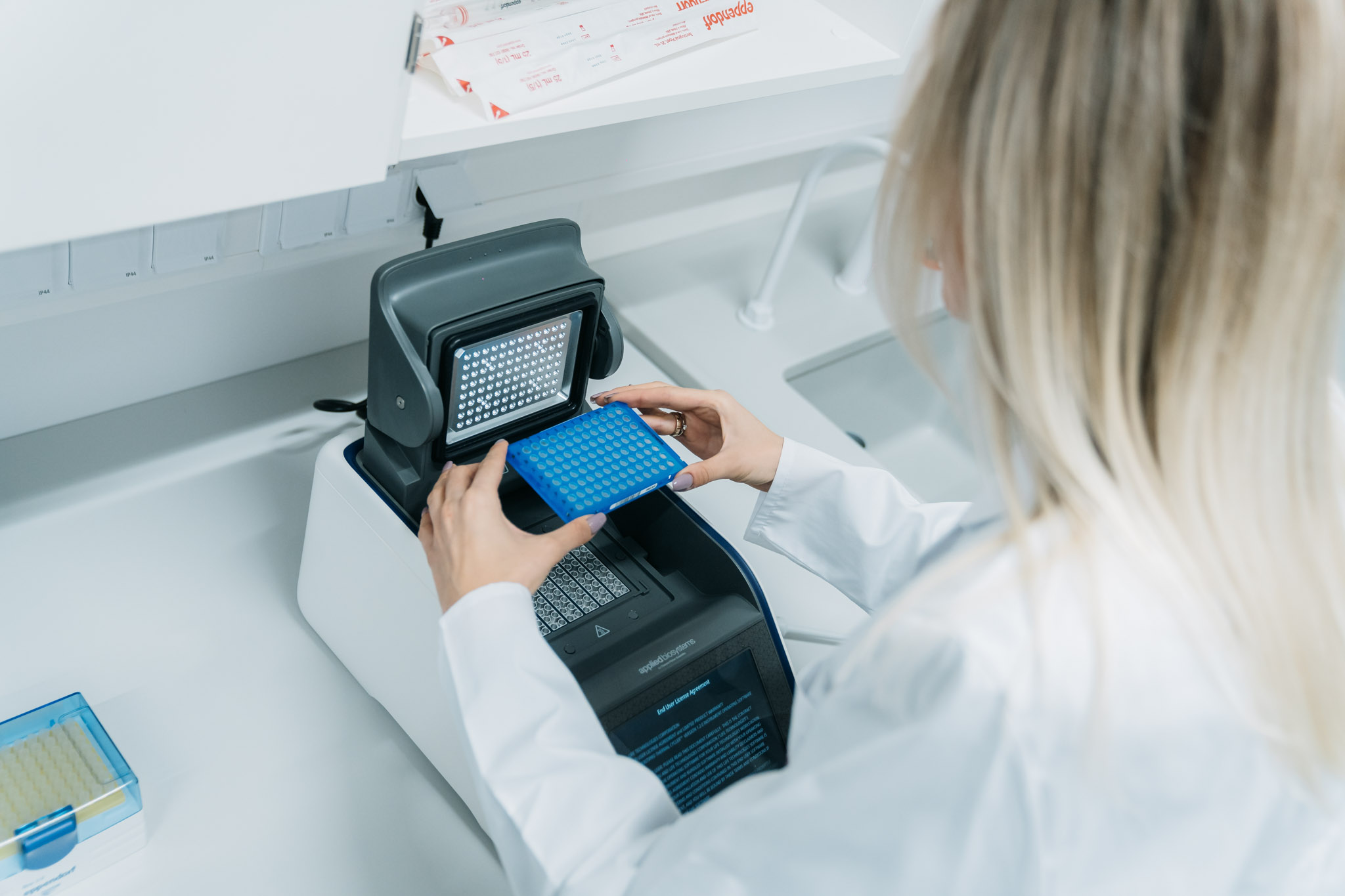 Laboratories of the VU Faculty of Medicine Science Center / Photo – Mantas Repečka
Laboratories of the VU Faculty of Medicine Science Center / Photo – Mantas Repečka
Developing computer algorithms to predict the course of a disease: entering the era of precision medicine
The new medical science complex also houses the Centre for Digital Medicine. This centre is expected to bring together data and medical scientists and contribute to the introduction of artificial intelligence technologies into the healthcare system.
According to Prof. Arvydas Laurinavičius, Director of the State Centre for Pathology, from the Faculty of Medicine at Vilnius University, digital medicine is a very broad field, ranging from health information standards, and data and process management, to machine learning and the use of artificial intelligence systems in clinical practice. According to Professor, the world is currently experiencing a digital transformation in medicine and rapid progress across various fields of medicine.
“On the basis of this centre, we will develop an open ecosystem that will bring together researchers working in the field of machine learning at VU MF. Interaction between different specialists, seamless and secure access to quality data and the ability to process it, are essential for successful activities. Health data is born during the clinical process, so it is important to improve the information systems used and, at the same time, to create the conditions for the introduction of artificial intelligence systems. In other words, we will aim to be both developers and users of systems. It will also be a place for students of different specialities and levels to express themselves – working in a digital environment eliminates the boundaries of time, space and imagination,” added Prof. Laurinavičius.
According to him, the research groups at VU MF, together with their partners, are also developing algorithms and new digital tools. For example, an immunogradient developed by the researchers – the Digital Pathology Algorithm – allows them to access the spatial distribution of lymphocytes in the zone of interaction between the cancer and the host tissue and to predict the course of disease. “This algorithm allows us to measure whether a patient’s immune cells – the lymphocytes – in the cancer microenvironment are penetrating deeper into the cancer tissue. In other words, how many lymphocytes have the enthusiasm or the fury to fight back. This is measured spatially and appears to correlate reliably with a patient’s prognosis. We have already received US patent approval for this method and are awaiting the European evaluation.”
While pathology data is very comprehensive (one square millimetre of microscopic image can hold one CT scan), even more value is gained by combining different types of – data, including multimodal. “For example, machine learning that integrates pathology, laboratory, radiology, disease clinic, workflow and response to treatment enhances the quality of artificial intelligence systems. All of this will help us in the era of precision medicine,” concluded the researcher.
